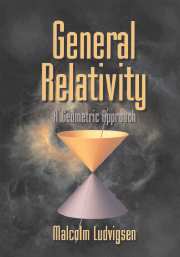15 - The Spacetime of the Universe
Published online by Cambridge University Press: 04 June 2010
Summary
We now turn to the spacetime description of the universe as a whole. At first sight this may seem like a formidable undertaking, but as we shall be interested in only gross, very large-scale features – a “point event” will contain many galaxies and extend for millions of years – it turns out to be quite tractable.
Due to the high degree of symmetry possessed by the universe on a suitably large scale, much of the mathematical machinery developed in the previous chapters (metric tensors, curvature tensors, etc.) is not strictly necessary to obtain an overall picture. Indeed, in this chapter, we shall not even use the spacetime metric, and simply content ourselves with the properties of photons and null rays. This, as we shall see, gives an adequate description of the causal properties of the universe, particularly as regards horizons. The full, relativistic treatment will be left to the next chapter.
The Cosmological Principle
Roughly speaking, the cosmological principle states that, at any given time, the universe looks the same to all observers in all typical galaxies (galaxies that do not have any large peculiar motion of their own, but are simply carried along with the general cosmic flow of galaxies), and in whatever direction they look. Clearly this principle is not true on a human scale – if it were true, the universe would be a pretty boring place. Even on a very large astronomical scale it is false. For example, our galaxy (the Milky Way) belongs to a small local group of other galaxies, which in turn lies near the enormous cluster of galaxies in Virgo.
- Type
- Chapter
- Information
- General RelativityA Geometric Approach, pp. 175 - 181Publisher: Cambridge University PressPrint publication year: 1999



